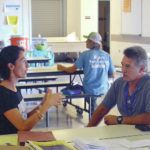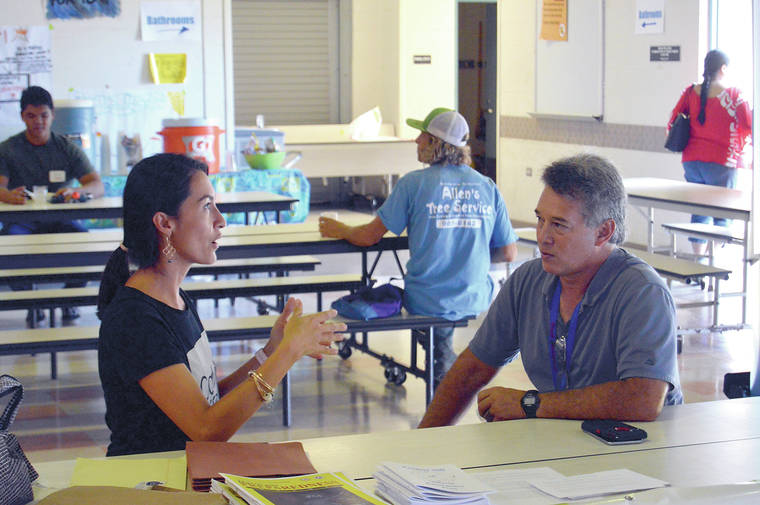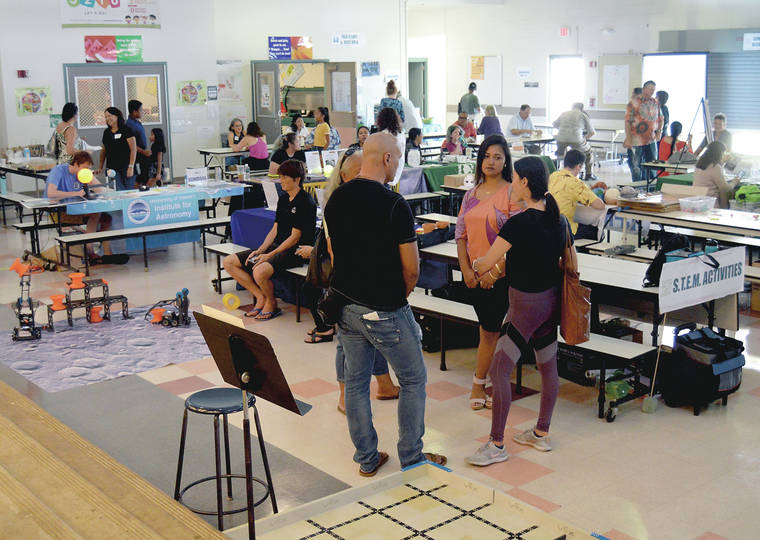A disaster recovery expert said Saturday that the Big Island is going to have to tell its story in a compelling way to get its share of federal recovery dollars after a 2018 that saw 700-plus homes destroyed by lava from Kilauea volcano and disastrous flooding from the remnants from Hurricane Lane.
“The last two years for the United States have been brutal. Natural disasters of one kind or another cost the United States over $300 billion,” said Stephen Jordan, CEO of the Institute for Sustainable Development in Alexandria, Va. His remarks came during a panel presentation that was part of a community event by the county at Keaau High School on Kilauea recovery.
“In 2018, there were 14 billion-dollar disasters. They say as much as 10 percent of the United States’ territory was affected by some sort of major event or another. In 2019, we’re already looking at floods in the Midwest, we’re already looking again at major challenges in California and other places,” Jordan said.
“There was an emergency supplemental bill that was just passed (by Congress) appropriating $19 billion. But that $19 billion is going to be divided among all of the different places that were impacted. So one of the things that we have to do with the county is that we have to tell the best possible story to capture what the impacts were, what we want to do going forward and how we plan to do it. And that is the process that the institute is supporting here now.”
Jordan said that a year after the eruption, “the medium- to long-term damage starts to manifest itself.”
“One year is not long enough. It may be five years before you really have the kind of recovery. So the work is just started,” he said. “It’s important, after CNN leaves, to keep working on it, to keep talking to the people who are providing the resources to mobilize recovery. Right now, we’re in the stage of establishing the economic baseline, so we can say, ‘This is where we were and this is what … impacts happened.’ So hopefully, it tells that story.”
“… One thing that the United States does well is the short-term disaster response work. It really focuses in on that. But then, once CNN and the people leave, it’s like they move on to the next thing and they kind of forget about what was going on before.”
Paul Brewbaker, a private economic consultant and former chief economist for Bank of Hawaii, noted that “tourism is not just the largest export, it’s the principal export” for Hawaii Island as well as the state.
He said that following the so-called “Great Recession” in 2008, the Hawaii economy had a relatively steady trend upward until the eruption of Kilauea volcano in May 2018.
“And then what happened, in addition to the loss of the visitors themselves … you have this compression in spending because the hotels experience … lower occupancy, the room rates decline … and that’s what we’re dealing with,” he said. “… Had the eruption not occurred as it did, we would have probably kept on going (upward) until hotels are sold out. We were 10 percentage points away from being sold out. We were good to go for another 10, 15 years. It was a good long run we could have had.
“Tourism performance, at least in the lodging sector, was accelerating. It was getting better at a faster rate. We lost not only by falling behind, but falling behind of a lot more upside at that particular moment. And that makes it very unfortunate.”
Brewbaker estimated the losses since the eruption include “at least $400 million to date on visitor arrivals and expenditures” in an industry that brought $2.4 billion in visitor spending in 2017.
“It could be $500 million instead of $400 million,” he said. “The point is, it’s serious money. It’s a serious loss of export revenue that has far-reaching impacts. “The (Hawaii) Volcanoes National Park people have estimated their own loss at $100 million … and that sounds about right.”
He said the economic acceleration could’ve meant growth that could’ve brought the visitor industry to $2.7 million in 2018 had Kilauea not erupted.
According to Brewbaker, the disaster-weakened economy manifests itself “in other dimensions,” as well.
“About 5,000 persons are no longer employed on the Big Island, compared to right before the eruption before May last year,” he said. “About 1,500 jobs have been lost. … And … the unemployment rate went up a percentage point-and-a-half. The good news is that the last couple of months, we’ve seen some improvement in the unemployment rate on the Big Island. Unfortunately, most of that’s coming from the fact that the labor force is shrinking now. So, people are bailing. They waited a year, and they’re exiting.”
Despite the damage to homes and other infrastructure and the negative impact on tourism, Brewbaker said there is reason for optimism in the long term.
“We actually do have a really good tool kit now to understand how to assess the nature of the impacts and how to think about recovery and redevelopment moving forward,” he said.
Email John Burnett at jburnett@hawaiitribune-herald.com.












